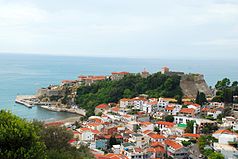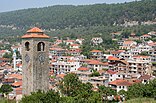Ulcinj
Ulcinj
Улцињ Ulqin | |
|---|---|
From the top, View over the city, Pasha Mosque, The Clocktower | |
| Coordinates:41°55′N19°12′E/ 41.92°N 19.20°E | |
| Country | |
| Municipality | |
| Settlements | 39 |
| Government | |
| • Mayor | Genci Nimanbegu (FORCA) |
| • Ruling coalition | FORCA—DPS–SD–SDP–DSCG–DP–BS |
| Area | |
| •Townandmunicipality | 255 km2(98 sq mi) |
| Population (2023 census) | |
| • Rank | 11th in Montenegro |
| • Density | 79.47/km2(205.8/sq mi) |
| •Urban | 11,488 |
| •Rural | 9,907 |
| • Municipality | 21,395 |
| Demonym(s) | Ulcinjani Ulqinakë |
| Time zone | UTC+1(CET) |
| • Summer (DST) | UTC+2(CEST) |
| Postal code | 85360 |
| Area code | +382 30 |
| ISO 3166-2 code | ME-20 |
| Car plates | UL |
| Website | Official Website |
Ulcinj(Cyrillic:Улцињ,pronounced[ǔlt͡siɲ];Albanian:UlqinorUlqini;Italian:Dulcigno) is a town inCoastal regionofMontenegroand the capital ofUlcinj Municipality.[1]It has an urban population of 11,488.[2]
As one of the oldest settlements in theAdriatic coast,it was founded in 5th century BC. It was captured by theRomansin 163 BC from theIllyrians.With the division of theRoman Empire,it was a part of theByzantine EmpireandSerbian Kingdomin theMiddle Agesuntil theRepublic of Venicecaptured it in 1405.[3]It was known as a base forpiracy.[4]
In 1571, Ulcinj was conquered by theOttoman Empirewith the aid of North African corsairs after theBattle of Lepanto.[5]The town gradually became a Muslim-majority settlement. Under the Ottomans, numerous oriental-stylehammams,mosques,and clock towers were built. Ulcinj remained a den of piracy until this was finally put to an end byMehmed Pasha Bushati.In 1673, the self-proclaimedJewish MessiahSabbatai Zeviwas exiled here fromIstanbul.[6]
Ulcinj remained an Ottoman town for more than 300 years until it was ceded to thePrincipality of Montenegroin 1878.[7]It is a former medieval Catholic bishopric and remains a Latintitular see.[8]
Ulcinj is a destination for tourists, because of itsLong Beach,Lake Šas,Ada Bojana Islandand for its two-millennia-oldUlcinj Castle.[9]There are26 mosquesin the town and surrounding countryside.[10]Ulcinj is the centre of theAlbanian community in Montenegro.[11]
Names
Early historianLivy(59 BC–AD 17) mentioned it,[12]as didPliny the Elder(23–79),[13]who mentioned it asOlcinium,its old nameColchinium,"founded by [settlers from]Colchis"(Olchinium quod antea Colchinium dictum est a Colchis conditum).[13]Ptolemy(90–168) mentions the city as GreekOulkinion(Ουλκίνιον).[14]Although the ancient writers preferred a connection with Cholchis, the name of the settlement appears to be connected with theAlbanianwordujkorulk(meaningwolfinEnglish),[15][16]fromProto-Albanian*(w)ulka,fromProto-Indo-European*wĺ̥kʷos.[17]In modern Albanian, it is known asUlqin.The name, through Late (Vulgar) Roman, becameMiddle LatinUlcinium,Italian:Dulcigno(pronounced[dulˈtʃiɲɲo]), andDolchin,modern ItalianDulcignoSlavic:Ulcinj,Old Serbian: Льцин, Ульцин andTurkish:Ülgün.
Geography
Neighbourhoods
- Çarshia(mn.Čaršija), is aneighbourhoodand town centre which connects the old and new parts (neighbourhoods). In 2009 it was reconstructed, with theasphaltbeing changed intosettand the water and electrical system were changed. The neighbourhood has some 200 shops. It has an oriental atmosphere. There are twomosqueslocated in this area, theNamazgjahu MosqueandKryepazari Mosque.
History
Antiquity
Ulcinj is an ancient seaport.[18]The wider area of Ulcinj has been inhabited since theBronze Age,based on dating ofIllyriantombs (tumuli) found in the village ofZogaj,in the vicinity of Ulcinj. The town is believed to have been founded in the 5th century BC by colonists fromColchis,as mentioned in the 3rd century BC poem byApollonius of Rhodes.Illyrians lived in the region at the time as there are traces of immenseCyclopean wallsstill visible in the old Citadel.[18]
All the way in the pre-medieval period, Ulcinj was known as one of the pirate capitals of theAdriatic Sea.This is also seen during the later period ofIllyrian Kingdom.Inhabitants of Ulcinj were known before time ofChrist,especially from 20 BC to around 300 AD, to be very confrontational to those who were foreigners to their land; they were especially meticulous about border disputes as well.
Roman

In 168 BC, during theThird Illyrian War,Olcinium broke withGentiusand defected to the Romans (Livy45:26:2). Under Roman rule the town received the status ofoppidum civium Romanorum(settlement of Roman citizens), only to be later grantedmunicipium(independent town) status.
ThePeriplus Maris Erythraeinames several Indian portsfrom where large ships sailedin an easterly direction toKhruse(Kruče - seaside village in Ulcinj).[19]
From circa 820, the city was the see of aDiocese of Ulcinj,which was only suppressed in 1532, and would be revived as a Latintitular bishopric.
Medieval period
In the 9th century, it was in theDyrrhachium theme,a military governorate of theByzantine Empire.In 1010,TsarSamuel of Bulgaria(r. 997-1014†) failed to conquer the town during thewar against the Byzantines.
By 1040,archonStefan VojislavofDukljaconquered the region. In 1183,Serbian PrinceStefan Nemanjaconquered Olcinium and the town prospered as one of the most significant coastal towns. Ulcinj remained in Nemanjić hands in theirKingdomandEmpire,and after the death ofEmperor Dušan(r. 1331-1355†), the region, known asLowerZeta,was under the supervision ofgospodinŽarko,avoivodeof EmperorUroš the Weakuntil his death in 1360. Žarko's lands were then held by theBalšićfamily. Under Balšić control, Ulcinj continued to be an important town and alsominted coins.
Venetian and Ottoman rule
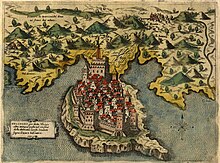
According to historian Luigi Paulucci at the time of the Venetians the town was half Albanian, a quarter Venetian and one quarter Slavic.[20]
The Venetians attempted to capture the town twice, in1696and1718,but were unsuccessful on both occasions.
During the 19th century, the town began to regain its position as a flourishing port. The geographerAntonio Baldaccireported amerchant marineof 500 ships plying the trade routes between the Adriatic and Mediterranean coasts.
In 1867, Ulcinj became akazaof theİşkodra sanjakofRumeliveyalet. After theCongress of Berlinin 1878, borders between Montenegro and the Ottoman Empire were redrawn, withPlavandGusinjebeing ceded to Montenegro. But Muslim Albanian resistance prevented the Montenegrins from taking over Plav and Gusinje, so the Great Powers in 1880 decided to reverse the territorial transfer and offered Ulcinj, then also known as Dulcigno, to Montenegro as compensation.[citation needed]This led to a dispute between the Ottoman Empire and the Principality of Montenegro as the Ottoman Empire initially refused to recognize the treaty's provisions regarding Dulcigno. The Ottoman garrison in the town had been in place since the 16th century, but Montenegro claimed that the town and its surrounding territory were historically part of its territory.
In May 1880, the Great Powers (Britain, France, Germany, Austria-Hungary, Italy, and Russia) protested diplomatically and organized a naval demonstration off the coast of Dulcigno to put pressure on the Ottoman Empire to resolve thedisputepeacefully. The Ottoman Empire eventually agreed to cede the town and surrounding territory to Montenegro in exchange for compensation.
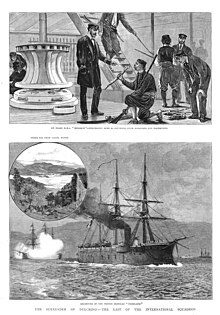
The surrender of Dulcigno to Montenegro marked a significant expansion of Montenegro's territory and was seen as a diplomatic victory for the Great Powers, who had prevented a potentially violent conflict in the region.[citation needed]
After the city's annexation to Montenegro, of its 8,000-strong population about 3,000 Albanians left and settled elsewhere in northern Albania. 142 Montenegrin families were brought to settle in the outskirts of Ulcinj in the 1880s. The population of Ulcinj steadily decreased until the post-WWII period.[21]
20th century to present
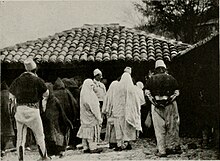
Ulcinj became a part of theKingdom of Montenegrofrom 1878 until 1918 when Montenegro was absorbed into theKingdom of Serbiafor a short time before all would be incorporated into the first of theYugoslavfederations at the end of the year. Ulcinj remained within a Montenegrin entity whilst a South Slavic state had existed until 2006 when which it became part of an independent Montenegro following a referendum.
During the 20th century, Ulcinj survived heavy declines and new ascents. Ulcinj was the second biggest town of Montenegro when it joined the kingdom in 1880. In just three decades, it backslided to 6th place for economic development and number of inhabitants (after Podgorica, Niksic, Cetinje, Tivar and Plava). During World War I Ulcinj was conquered by Austria-Hungary in 1916 and Italy on November 4, 1918,[22]and since 1920 it was part of the Serbo-Croatian-Slovenian Kingdom, later known as theKingdom of Yugoslavia.
As the southernmost city of the coast of the Kingdom of Yugoslavia, Ulcinj had a strong turnaround in the 1930s with the development of the tourist industry. At that time hotels were built such as Krištja, Republic, Jadran and Koop (later Galeb). World War II halted economic momentum. From 1941 to 1944, Ulcinj was under the Albanian administration. On November 7, 1943, Ulcinj was bombarded by Allied forces, with over 46 people killed and many more injured. TheYugoslav Partisanstook Ulcinj on November 26, 1944, and the city become part ofSocialist Yugoslavia.[23][24][25]
The 1950s and 1960s marked the greatest period of economic development for Ulcinj, with the construction of a range of modern hotels in the city and the Great Plain, as well as major economic collectives (NHT "Riviera of Ulcinj", "Agroulqini", Primary Building Company, "Otrantkomerc", "Ultep" and others). In the catastrophic earthquake on April 15, 1979, the city was severely damaged, but after only a few years, with the solidarity of the citizens of entire Yugoslavia, it was quickly renovated. Ulcinj at the end of the eighties had about 40 percent of the tourist turnover in Montenegro, while two-thirds of the guests were foreign, mostly German.
During the Kosovo War, in 1998 and 1999, thousands of Kosovo Albanians flocked to Ulcinj and its surroundings, where they were welcomed in the best possible conditions by the ethnic Albanian population of Ulcinj and the surrounding area.
Demographics
| Year | Pop. | ±% |
|---|---|---|
| 1948 | 4,385 | — |
| 1953 | 4,919 | +12.2% |
| 1961 | 5,705 | +16.0% |
| 1971 | 7,459 | +30.7% |
| 1981 | 9,140 | +22.5% |
| 1991 | 11,144 | +21.9% |
| 2003 | 10,828 | −2.8% |
| 2011 | 10,707 | −1.1% |
| 2023 | 11,488 | +7.3% |
| Source: pop-stat.mashke.org[26] | ||
Ulcinj is the administrative centre ofUlcinj Municipality,which has a population of 21,395. The town of Ulcinj itself has a population of 11,488. Ulcinj Municipality is the centre of theAlbanian community in Montenegro.It is one of two municipalities in Montenegro whereAlbaniansform the majority with 70%, the other beingTuziwith a 68% majority.
|
|
Ethnicity, language and religion
The majority ethnic group in Ulcinj areAlbanians.The largest spoken language isAlbanian.
Population by ethnicity (2011 census):
Population by mother tongue (2011 census):
Population by religion (2011 census):
Tourism

Ulcinj is a tourist destination in summer. In January 2010, theNew York Timesnamed ranked the south coast region of Montenegro, featuringVelika Plaza,Ada Bojana,and theHotel Mediteran,as one of "The Top 31 Places to Go in 2010".[27]
Although Ulcinj is still undiscovered by many travelers from larger countries, repeat tourists and an increasing amount of first-time visitors make it a hot spot for vacationers between the months of May and September. It is most famous for its sandy beaches.[citation needed]The most valuable resource of the Ulcinj riviera isVelika plaža(Albanian: Plazha e Madhe; English: Long Beach), which is a 12 km (7.5 mi) long stretch of sandy beach and the longest beach on the Montenegrin coast. There is a small pebble beach calledLadies Beachwhich folk tradition holds to have qualities conducive to fertility.
There is also a beach calledMala Plaža(Albanian: Plazhi i Vogël; English: Small Beach) which is much smaller in size, but is located in the centre of town and very popular with visitors. "The Korzo", as it is called by locals, is apromenadewhich separates a street lined with coffee shops from Mala plaža. At night during the summer months, the Korzo is pedestrianised and families and young people gather. There are many more less known smaller beaches that serve as get-aways from the main tourist areas. Ulcinj has also a large number of religious buildings likemosques,türbesandchurches,includingPasha's Mosque,Sailors' Mosqueand St. Nicholas' Church.
Ulcinj's old town is a well preservedcastle-looking community that is left over from medieval times. The old town sits atop a mountain overlooking the shore and is a tourist attraction on its own.Ada Bojanais popular among foreign tourists fromWestern Europefor its peace and atmosphere.[citation needed]A largenaturistcampsite is located in Ada Bojana.Lake Šasand Ulcinj's salt pond are visited by birdwatchers, because Ulcinj and its surroundings are major resting points for over 200 bird species on their migration paths. There are numerous cafés, discos, and bars that dot the city that are usually filled to capacity throughout the summer. The majority of tourists that visit Ulcinj areAlbanians,Serbians, Croatians, Bosnians, Slovenians, Macedonians, Russians, Ukrainians, and other Europeans.
Education
| Montenegrin name | Albanian name | Location | Language(s) |
|---|---|---|---|
| Elementary schools | |||
| Osnovna škola"Boško Strugar" | Shkolla Fillore"Boshko Strugar" | Ulcinj | Montenegrin&Albanian |
| Osnovna škola"Maršal Tito" | Shkolla Fillore"Marshal Tito" | Ulcinj | Montenegrin & Albanian |
| Osnovna škola"Bedri Elezaga" | Shkolla Fillore"Bedri Elezaga" | Vladimir | Albanian |
| Osnovna škola"Marko Nuculović" | Shkolla Fillore"Mark Nuculloviq" | Donji Štoj | Montenegrin & Albanian |
| High schools | |||
| Srednja mješovita škola"Bratstvo i jedinstvo" | Shkolla e Mesme e Kombinuar"Vëllazërim Bashkim" | Ulcinj | Montenegrin & Albanian |
| Gimnazija"Drita" | Gjimnazi"Drita" | Ulcinj | Albanian |
Sports and recreation
The Ulcinj "south coast" region is well known for its active sports, recreation possibilities and hunting. Kitesurfing atAda Bojana,all manner of water sports atVelika plaža,scuba diving among wrecks and sunken cities, mountain biking, hiking, orienteering, cycling through the olive groves atValdanos,long walks along the pristine beaches of the south coast of Montenegro, even deep sea fishing on the Adriatic, lake fishing atLake Skadar,and river fishing inAda Bojana,Due to the fact that the favorable habitat for wild life, has excellent conditions of hunting tourism. This place is the haven of ornithological (gourmand) hunting inRečand Shenkol most common wildlife arewoodcock,Hare,Wild boar,andducks.
List of sport clubs in Ulcinj:
| Name | Sport | Competing | Founded | |
|---|---|---|---|---|
| Montenegrinname | Albanianname | |||
| Fudbalski klub"Otrant-Olympic" | Klubi Fudbolistik"Otrant-Olympic" | Football | Montenegrin Second League | 1921 |
| Košarkaški klub"Ulcinj" | Klubi i Basketbollit"Ulcinj" | Basketball | Montenegrin Basketball League | 1976 |
| RK Ulcinj | Klubi i Hendbollit"Ulcinj" | Handball | Montenegrin First League of Men's Handball | |
| Teniski klub"Bellevue" | Klubi i Tenisit"Bellevue" | Tennis | 2009 | |
| Omladinski fudbalski klub"Federal" | Klubi Futbolistik Rinor"Federall" | Football | South Region League | 2007 |
| Karate klub"Champions" | Klubi i Karates"Champions" | Karate | ||
| Karate Klub"Ulcinj" | Klubi i Karates"Ulqini" | Karate | ||
| Stonoteniski Klub"Valdanos" | Klubi i Ping Pongut"Valdanos" | Table Tennis | Cadet,Junior,Senior Montenegrin League | 2012 |
Climate
Ulcinj has aMediterranean climate(Csa) in theKöppen climate classification.[28]Winters are cool and very rainy, and summers are hot and humid with possible afternoon thunder showers. UnlikePodgoricawhich is located inland, temperatures rarely exceed 35 °C (95 °F) and seldom drop below 0 °C (32 °F).
| Climate data for Ulcinj,Montenegro(1961–1990, extremes 1949–present) | |||||||||||||
|---|---|---|---|---|---|---|---|---|---|---|---|---|---|
| Month | Jan | Feb | Mar | Apr | May | Jun | Jul | Aug | Sep | Oct | Nov | Dec | Year |
| Record high °C (°F) | 19.6 (67.3) |
26.7 (80.1) |
26.8 (80.2) |
31.7 (89.1) |
33.9 (93.0) |
37.6 (99.7) |
41.1 (106.0) |
41.0 (105.8) |
35.8 (96.4) |
32.6 (90.7) |
27.9 (82.2) |
20.7 (69.3) |
41.1 (106.0) |
| Mean daily maximum °C (°F) | 10.7 (51.3) |
11.6 (52.9) |
14.7 (58.5) |
17.9 (64.2) |
22.1 (71.8) |
26.2 (79.2) |
29.2 (84.6) |
29.2 (84.6) |
26.1 (79.0) |
21.3 (70.3) |
16.1 (61.0) |
12.1 (53.8) |
19.8 (67.6) |
| Daily mean °C (°F) | 7.1 (44.8) |
7.9 (46.2) |
10.6 (51.1) |
13.6 (56.5) |
17.9 (64.2) |
21.7 (71.1) |
24.4 (75.9) |
24.2 (75.6) |
21.2 (70.2) |
16.8 (62.2) |
12.2 (54.0) |
8.6 (47.5) |
15.5 (59.9) |
| Mean daily minimum °C (°F) | 4.1 (39.4) |
4.7 (40.5) |
7.2 (45.0) |
10.1 (50.2) |
14.1 (57.4) |
17.8 (64.0) |
20.2 (68.4) |
20.1 (68.2) |
17.3 (63.1) |
13.1 (55.6) |
9.0 (48.2) |
5.6 (42.1) |
11.9 (53.5) |
| Record low °C (°F) | −8.4 (16.9) |
−8.3 (17.1) |
−5 (23) |
0.4 (32.7) |
5.2 (41.4) |
8.9 (48.0) |
12.3 (54.1) |
10.6 (51.1) |
8.6 (47.5) |
1.1 (34.0) |
−2.2 (28.0) |
−5.6 (21.9) |
−8.4 (16.9) |
| Averageprecipitationmm (inches) | 149.3 (5.88) |
137.9 (5.43) |
115.7 (4.56) |
115.2 (4.54) |
66.9 (2.63) |
46.5 (1.83) |
25.2 (0.99) |
48.6 (1.91) |
84.6 (3.33) |
148.2 (5.83) |
173.7 (6.84) |
146.1 (5.75) |
1,257.9 (49.52) |
| Average precipitation days(≥ 0.1 mm) | 12 | 12 | 12 | 12 | 8 | 7 | 4 | 4 | 7 | 10 | 13 | 12 | 113 |
| Averagerelative humidity(%) | 66 | 64 | 66 | 70 | 71 | 69 | 62 | 63 | 66 | 67 | 69 | 67 | 67 |
| Mean monthlysunshine hours | 121.3 | 126.8 | 170.5 | 202.3 | 263.7 | 299.2 | 349.9 | 319.6 | 255.8 | 195.7 | 134.6 | 118.2 | 2,557.6 |
| Source: Hydrological and Meteorological Service of Montenegro[29][30] | |||||||||||||
Transport
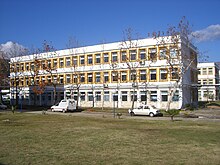
Ulcinj is connected with the rest of Montenegro by a two-lane highway. It is connected with other coastal towns by theAdriatic Motorway.Reaching inland is made possible by detouring from the Adriatic Motorway atBudvaorSutomore(through theSozina tunnel).
As of today, there are no airports in the city of Ulcinj. However, nearby airports inTivatandPodgoricaare both around 70 km (43 mi) away. There are regular flights toBelgradeandZürichfrom Tivat. Podgorica Airport has regular flights to majorEuropeand destinations throughout the year. Many tourists traveling to Ulcinj from abroad arrive to the city from the airport in Tivat due to its recent renovations and general ease of navigation. There are also intercity buses that connect to other towns in the country and buses that go to Serbia, Albania, Northern Macedonia, Greece, and Germany (during tourist seasons) as well Flex bus operates in this area connecting to Bana Luka (Bosnia) and Dubrovnik.
International relations
Ulcinj is a founding member of the Union of Albanian Municipalities in the Region.[31][32]Ulcinj istwinnedwith:[33]
 Berat,Albania
Berat,Albania Deçan,Kosovo[34]
Deçan,Kosovo[34] Liesing (Vienna),Austria
Liesing (Vienna),Austria Lukavac,Bosnia and Herzegovina[35]
Lukavac,Bosnia and Herzegovina[35] Serik,Turkey[36]
Serik,Turkey[36] Stari Grad (Sarajevo),Bosnia and Herzegovina
Stari Grad (Sarajevo),Bosnia and Herzegovina Staten Island,USA[37]
Staten Island,USA[37] Uzhhorod,Ukraine
Uzhhorod,Ukraine
Cooperation and friendship
Ulcinj also cooperates with:
 Durrës,Albania
Durrës,Albania
Notable people
- Đurađ II Balšić,Lord ofZetafrom 1385 to 1403, member of theBalšić noble family.
- Dritan Abazović,prime minister of Montenegro
- Jelena Balšić,daughter ofLazar of Serbia,author ofGorički zbornik,first woman writer in South Slavs
- Gjon Buzuku,Catholic priest who wrote the first known printed book in Albanian
- Pjetër Gjoka,actor and People's Artist of Albania
- Rizo Šurla,photographer, and actor of African descent
- John VIII or Giovanni Bruni,archbishop of Bar (1551–1571)
- Adrian Lulgjuraj,Montenegrin-Albanian singer
- Alex Rudaj,Albanian-American mobster
- Lika Ceni,Captain and Pirate Commander
- Rade Tovladijac,Serbian comic book artist
- Mark Gjonaj,Albanian-American politician
- Mujo Ulqinaku,Albanian officer and a People's Hero of Albania
- Sabbatai Zevi,İzmir born mystic, founder of the JewishSabbateanmovement
- Andrej Nikolaidis,writer
- Cafo Beg Ulqini,Leader of Second League of Prizren and Knight of the Order of Skandebeg[38]
- Božidar Đurašković,athlete
- Vladimir Mihailović,basketball player
- Gazmend Çitakuis an Albanian Montenegrin photographer, publisher, and librarian
Bibliography
References
- ^"Visit Ulcinj".Inspire your travels - latest.18 February 2018.Retrieved2021-06-18.
- ^"Statistical Office of Montenegro".MONSTAT.Retrieved2024-04-15.
- ^"Ulcinj".Discover Montenegro.2016-04-20.Retrieved2021-06-18.
- ^"The Ulcinj pirates – TO Ulcinj".TO Ulcinj – Welcome to TO Ulcinj.Retrieved2021-06-18.
- ^"Ulcinj in Middle Age – TO Ulcinj".TO Ulcinj – Welcome to TO Ulcinj.2018-11-10.Retrieved2023-05-09.
- ^"Sabbatai Zevi – TO Ulcinj".TO Ulcinj – Welcome to TO Ulcinj.2023-04-19.Retrieved2023-05-09.
- ^"The History of Ulcinj".Visit Montenegro.Retrieved2021-06-18.
- ^Čoralić, Lovorka (2011)."Verita d'alcuni heretici": The archbishop of Bar vs the count of Ulcinj - Two accusations, two testimonies (the sixteenth century) ".Acta Histriae.19(3): 407–418.
- ^"Ulcinj".My Guide Montenegro.Retrieved2021-06-18.
- ^"Ulcinj travel - Montenegro, Europe".Lonely Planet.2019-09-08.Retrieved2021-06-18.
- ^"Montenegro - People".Encyclopedia Britannica.Retrieved2021-06-18.
- ^Pavle Mijović (1970).Tragom drevnih kultura Crne Gore.Grafički zavod. p. 35.
- ^abC. Praschniker; A. Schober (1976).Arch?ologische Forschungen in Albanien und Montenegro.Рипол Классик. pp. 82–.ISBN978-5-87379-103-3.
- ^"16".Claudii Ptolemaei Geographia edidit Carolus Fridericus Augustus Nobbe.Vol. 1. sumptibus et typis Caroli Tauchnitii. 1843. p. 134.
- ^Wilkes, John (1992).The Illyrians.Wiley. p. 244.ISBN9780631146711."Names of individuals peoples may have been formed in a similar fashion, Taulantii from ‘swallow’ (cf. the Albanian tallandushe) or Erchelei the ‘eel-men’ and Chelidoni the ‘snail-men’. The name of the Delmatae appears connected with the Albanian word for ‘sheep’ delmë) and the Dardanians with for ‘pear’ (dardhë). Some place names appear to have similar derivations, including Olcinium (Ulcinj from ‘wolf’ (ukas), although the ancients preferred a connection with Cholchis."
- ^Birnbaum, Henrik; Puhvel, Jaan (1963). "The Position of Albanian".Ancient Indo-European Dialects.University of California Press. p. 108.
- ^Orel, Vladimir (1998).Albanian etymological dictionary.Brill. p. 484.ISBN9004110240.
- ^abRellie, Annalisa (2012).Montenegro.Bradt Travel Guides Ltd, IDC House, The Vale, Chalfront St Peter, Bucks SL9 9RZ, England: The Globe Pequot Press Inc. pp. 207–208.ISBN978-1-84162-381-8.Retrieved2013-06-20.
{{cite book}}:CS1 maint: location (link) - ^Donkin, Robin A. (2003),Between East and West: The Moluccas and the Traffic in Spices Up to the Arrival of Europeans,Diane Publishing Company,ISBN0-87169-248-1,page. 64
- ^Paulucci, Luigi (2005).Le Bocche di Cattaro nel 1810 Edizioni Italo Svevo.Trieste.
{{cite book}}:CS1 maint: location missing publisher (link) - ^Poláčková & Van Duin 2013,p. 80.
- ^"Gazzetta Ufficiale del Regno d'Italia N. 261 del 6 Novembre 1918".Gazzetta Ufficiale del Regno d'Italia.6 November 1918.Retrieved5 May2019.
- ^LTKU (1989),fq. 46
- ^Ćetković: DPS i Forca hoće da brišu istoriju Ulcinja
- ^Ružna strana lepote Ulcinja
- ^"Montenegro Census 2023".2024-04-15.
- ^Williams, Gisela (7 January 2010)."The 31 Places to Go in 2010: 24. Montenegro".New York Times.
- ^Peel, M. C. et alUpdated world map of the Köppen–Geiger climate classification.Hydrol. Earth Syst. Sci. 2007, Volume 11(1027–5606) pp1633–1644 DOI 10.5194 Hess-11-1633-2007.
- ^"Climate: Bar"(in Montenegrin). Hydrological and Meteorological Service of Montenegro.Retrieved6 March2021.
- ^"Dnevni prosjeci i ekstremi"(in Montenegrin). Hydrological and Meteorological Service of Montenegro.Retrieved6 March2021.
- ^"Zyrtarizohet UBSHR, mbledh Konferencën e parë"(in Albanian). Unioni i Bashkive Shqiptare (UBSHR). 21 November 2016.Archivedfrom the original on 2 October 2021.Retrieved3 October2021.
- ^"Politikat Lokale – Bashk olitikat Lokale – Bashkëpunimi Ndërkomunal në K ëpunimi Ndërkomunal në Kosovë"(in Albanian).University for Business and Technology(UBT). p. 42.Archivedfrom the original on 12 August 2021.Retrieved3 October2021.
- ^"Bratimljenje"(PDF).database.uom.me(in Montenegrin). Zajednica opština Crne Gore. January 2013. p. 53.Retrieved2021-07-07.
- ^"Vendim për binjakëzimin e Komunës së Decanit me Komunën e Ulqinit"[Decision on the twinning of the Municipality of Decani with the Municipality of Ulcinj](PDF)(in Albanian). Deçan Municipality. 31 July 2015.
- ^""Bratimljenje" Lukavca i Ulcinja od posebne važnosti za privrednu saradnju ".opcina.lukavac.ba(in Bosnian). Lukavac. 2015-05-12.Retrieved2021-07-07.
- ^"Ceremonia në Serik: Nënshkruhet protokolli për binjakëzim".ul-info.com(in Albanian). UL Info. 2014-09-05.Retrieved2021-07-07.
- ^Porpora, Tracey (3 February 2024)."Did you know Staten Island now has a sister city across the globe?".New Haven Independent.Retrieved5 February2024.
- ^"Nishani dekoron Cafo Beg Ulqinin me Titullin" Kalorës i Urdhrit të Skënderbeut "- Video".20 April 2016.
Sources
- Poláčková, Zuzana; Van Duin, Peter (2013)."Montenegro Old and New: History, Politics, Culture, and the People"(PDF).Studia Politica Slovaca.VI(1).

